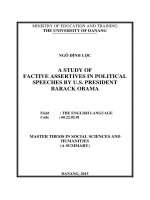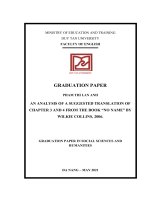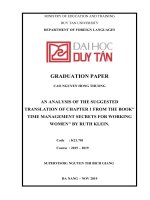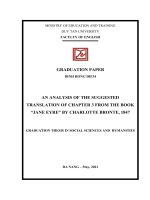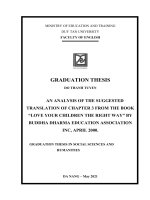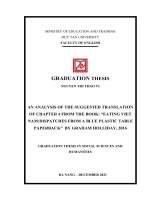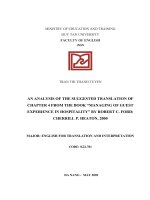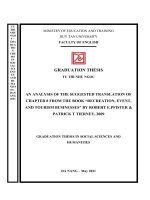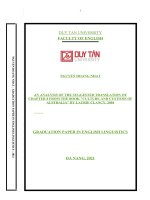GRADUATION THESIS THE ANALYSIS OF a SUGGESTED TRANSLATION OF CHAPTER 8 FROM THE BOOK THE MAGIC IN YOUR MIND BY u s ADERSEN, 2012
Bạn đang xem bản rút gọn của tài liệu. Xem và tải ngay bản đầy đủ của tài liệu tại đây (395.95 KB, 76 trang )
MINISTRY OF EDUCATION AND TRAINING
DUY TAN UNIVERSITY
FACULTY OF ENGLISH
GRADUATION THESIS
NGUYEN THI KIEU OANH
THE ANALYSIS OF A SUGGESTED TRANSLATION
OF CHAPTER 8 FROM THE BOOK
“THE MAGIC IN YOUR MIND”
BY U.S. ADERSEN, 2012
GRADUATION THESIS IN SOCIAL SCIENCES
AND HUMANITIES
DA NANG - May 2021
MINISTRY OF EDUCATION AND TRAINING
DUY TAN UNIVERSITY
FACULTY OF ENGLISH
GRADUATION THESIS
NGUYEN THI KIEU OANH
THE ANALYSIS OF A SUGGESTED TRANSLATION
OF CHAPTER 8 FROM THE BOOK
“THE MAGIC IN YOUR MIND”
BY U.S. ADERSEN, 2012
Major : English for Translation and Interpretation
Code
: 701
SUPERVISOR: NGUYEN THI BAO YEN, M.A
DA NANG – May 2021
3
ACKNOWLEDGEMENT
To teachers in Duy Tan university!
To my supervisor – Ms. Yen!
With the support of my professors, family, and friends, I was able to gain
valuable experience and knowledge during my four years at university. I am grateful
to all of you for your assistance, invaluable knowledge, and valuable lessons that
will benefit me in the future, especially in my career.
First and foremost, I'd like to express my heartfelt gratitude to the faculty
members who have consistently taught and aided me during my four years at the
school. During my time at school, I learned a lot of valuable information. It has
been very beneficial to me. Not only am I developing my skills, but I'm also getting
help for my future career.
I'd like to express my gratitude to Ms. Yen in particular for her invaluable
and thorough advice, comments, and suggestions, as well as her excitement and
unwavering commitment during this research. Without her invaluable assistance,
guidance, and motivation, I would not have been able to complete this graduation
document.
In addition, the flaws in this graduation paper are inevitable. As a result, I am
hoping for sympathy from teachers and colleagues.
At last, I do wish all of you good health and success.
Sincerely,
Oanh
Nguyen Thi Kieu Oanh
Supervisor: Nguyen Thi Bao Yen M.A
Student: Nguyen Thi Kieu Oanh
4
STATEMENT OF AUTHORSHIP
Except where reference is made in the text of the thesis, this thesis contains no
material published elsewhere or extracted in the whole or in part from a thesis by
which have qualified for or been awarded another degree or diploma.
No other person’s work has been used without due acknowledgement in the
thesis.
This thesis has not been submitted for award of any degree or diploma in any
other tertiary institution.
Da nang, May 2021
Nguyen Thi Kieu Oanh
Supervisor: Nguyen Thi Bao Yen M.A
Student: Nguyen Thi Kieu Oanh
5
ABSTRACT
The graduation paper is performed with the aim of translating the chapter 8
in “The Magic In Your Mind” by U.S. Adersen, 2012. This graduation paper
translates the English language into Vietnamese language and analyzes two version
about syntax, semantic and some difficult structures and vocabularies. Besides, the
writer gives some difficulties in translation and suggests solutions to solving this
problem.
Did you realize how important it is to think positively and effectively?
However, if you are not aware of the power of the mind in practice, it is we who
assist individuals in overcoming all obstacles to achieve resounding achievement
that provides you with the potential. Master her life by cultivating the lifestyle you
consciously desire. The book The Magic In Your Mind empowers her to take
control of her life and deliberately create the lifestyle she desires.
In the novel, a man with great motivation has surpassed himself to show that
he is just like the rest of us. I am confident that there will be people who feel as if
they have no reason to live. After reading, I am confident that they will reconsider
their position and find hope for themselves. I'd like to tell all that no matter what
happens, we all learn to rise because we were given a beautiful blessing when we
were born.
Supervisor: Nguyen Thi Bao Yen M.A
Student: Nguyen Thi Kieu Oanh
6
ABBREVIATIONS
SL
: Source Language (English)
TL
: Target Language (Vietnamese)
P
: Paragraph
S
: Subject
V
: Verb
C
: Compliment
P2
: Past Particple
N
: Noun.
Supervisor: Nguyen Thi Bao Yen M.A
Student: Nguyen Thi Kieu Oanh
7
TABLE OF CONTENTS
Supervisor: Nguyen Thi Bao Yen M.A
Student: Nguyen Thi Kieu Oanh
8
CHAPTER 1: INTRODUCTION
1.1. Rationale
Life must have unfolded in a variety of ways, both large and small, testing our
courage. How can we firmly psychology as unpredictable accidents happen to a
human being? “In life, ten percent of what happens is due to chance, and ninety
percent is due to choice.” Look for the silver lining of all that isn't meant to happen
to you. We consider how we tend to live in this manner when thoughts contribute to
behaviour. Negative emotions, such as “black clouds” obstruct our view, cause us to
lose our bearings, and find it impossible to consider other good aspects in
existence.When something unforeseen occurs, once we look at it objectively, we
will always see the goodness, the beauty, the bright side of the problem, even once
the occurrence occurs, we have the potential to turn the bad into good, always
looking for The steps to improve something is also a constructive way of thinking.
It would also be easier for you to cope with the challenges and difficulties of
your life if you have a good outlook. Most people nowadays live without a sense of
meaning. It implies to exist rather than to live. They have no idea that they are alive
and have lost all will to exist. Furthermore, real happiness is tough to come by for a
responsible person.
“The Magic In Your Mind” was written by U.S. Adersen to help readers
understand how you can as someone who is goal-oriented you already know the
importance of having positive and productive thoughts. In fact, it’s so important that
it’s the barrier between mediocrity and extravagant success. This textbook will
speak you the basics of your mind. As a result, this paper will focus exclusively on
translating chapter 8 “OVERCOMING OPPOSITION”
from English into
Vietnamese and analyzing some necessary issues so that readers can approach and
understand them easily. I hope that through the suggested version, I can give
necessary information and knowledge for everyone who wants to know clearly
about this field.
Supervisor: Nguyen Thi Bao Yen M.A
Student: Nguyen Thi Kieu Oanh
9
1.2. Aims and Objectives
1.2.1. Aims
The aim of this research is to evaluate the English translational version of the
book “The Magic In Your Mind” from three perspectives, namely lexical,
syntactic, and interpretation, in order to improve my translating and analyzing
abilities. The analysis then recommends some optimal solutions for problems and
challenges with translation, terminology, and structure.
1.2.2. Objectives
After completing my graduation paper, I acquired the following targets:
- To sum up knowledge I learned in the past.
- To get more knowledge about translating a social media document and help
me get experience in book translating.
- To firmly seize how to translate and analyze difficult words and challenging
structures.
- To give a translated version of the book, while helping the reader understand
his own mind and how to transcend himself.
- To remove language barriers to help Vietnamese people understand clearly
the book.
1.3. Scope of the Study
The text that I selected to translate is “The Magic In Your Mind” by U.S.
Adersen, 2012. The graduation paper is translated from the original version and
given the analysis of a suggested translation of the book. Besides, the paper will list
some difficulties that students face in tourism translation. Finally, some essential
solutions are suggested.
1.3.1. The text features
This book reveals a mental magic that ensures greater accomplishment and
achievement. Since they have been unsuccessful, many people have trapped
themselves in jails of their own making. The Magic in Your Mind teaches the magic
that allows men to become free and develop into the picture of their true selves.
Supervisor: Nguyen Thi Bao Yen M.A
Student: Nguyen Thi Kieu Oanh
10
Perfect movement and functions flow from a deep belief of the mental cause of
all. A person alters the state of his outer world by altering the state of his inner
world first. All he receives from the outside is the product of his own awareness.
When he shifts his mind, he shifts his perspective, and therefore his perception of
the world. He is on the right track to his target and he understands the mechanism
and impact of mental visualization.
In the book, the man with huge motivation has overcome himself to prove
himself as an ordinary person like everyone else. I am sure that there will be people
who have no purpose to live .After reading , they will change their minds and find
motivation for themselves. I want to remind everyone that no matter what fate may
be, we must know how to rise because we were born as a wonderful gift.
1.3.2. The Text Length
This book includes 12 chapters with 254 pages, but the time is limited so I
have translated only some 10 parts in the chapter 8 with 4,039 words in length . The
name of chapter 8 is “OVERCOMING OPPOSITION" in 15 sections from pages
113 to pages 126.
1.3.3. The Text Organization
The Magic in Your Mind teaches the magic by which men become free and
begin to grow into the image they are meant to be. A man changes the state of his
outer world by first changing the state of his inner world. Everything that comes to
him from outside is the result of his own consciousness. This book is divided into
12 chapters and the text I choose belongs to chapter 8 of the book.
The text is divided into 10 different sections and it is organized as follows:
1. EMOTIONAL BLIND SPOTS
2. WILLINGNESS TO ENTER CONFLICT
3. FACING FEAR
4. DESTINY AND UNDERSTANDING
5. THE TEMPERING PROCESS
6. CREATIVE WORK IS A PRAYER
Supervisor: Nguyen Thi Bao Yen M.A
Student: Nguyen Thi Kieu Oanh
11
7. INDOMITABLENESS
8. NO ENDEAVOR IS IN VAIN
9. THE CONQUEST OF SELF
10. GUIDING PRINCIPLE
1.3.4. The text source
This text comes from the book “The Magic In Your Mind ” published by
Thomas Nelson & Sons,New York, 1961 . This book is written by U.S. Adersen
,was an American football player and self-help and short story author during the
1950s and 1960s.
1.4. Method of the study
- Reading (scanning and skimming) the whole document to get the key points.
- Reading the chapter that were carefully selected to obtain details.
- Translating the language and taking notes on complicated terminologies,
phrases, and text structures.
- Discussing terminologies, phrases, and structures with the administrator,
coworkers, and relatives, and linking to such terminologies, expressions, and
structures on the Internet.
- Finishing the text and presenting a proposed edition.
Supervisor: Nguyen Thi Bao Yen M.A
Student: Nguyen Thi Kieu Oanh
12
CHAPTER 2: THEORETICAL BACKGROUND
2.1.Translation Theory
Translation theory is involved in a number of certain types of relationship
between languages and is consequently a branch of comparative linguistics.
Translation may be set up and is performed between any pair of languages or
dialects “related” or “unrelated” and with any kind of spatial, temporal, social and
other relationships between them.
A concept may be described in a variety of ways. Everyone has their own point
of view, resulting in a variety of meanings. As a result, there are several definitions
of translation. Linguists around the world have described translation in terms of
how they interpret it. Examples of that can be found in the definitions below:
“Translation is the act of transferring through which the content of a text is
transferred from the SL into the TL.”
[Foster , 1958]
“Translation is basically a change of form (change from one state or form to
another, to turn into one’s own or another language)”
[Merriam-Webster dictionary, 1974]
“Translation is an operation performed on languages: a process of substituting
a text in one langugage for a text in another”
[Catford, J 1965]
“Translation is the process of finding a target language (TL) equivalent from a
source language (SL) utterance.”
[Pinhhuck , 1977]
“Translation is the expression in another language (TL) of what has been
expressed in one language (SL), preserving semantic and stylistic equivalencies.”
[Bell R T, 1991]
“Translation is to be understood as the process whereby a message expressed in
a specific source language is linguistically transformed in order to be understood
by readers of the target language ”
[Houbert,1998]
To summarize, translation is the process of translating a text from one language
into another while maintaining the same semantics and literary style.
Supervisor: Nguyen Thi Bao Yen M.A
Student: Nguyen Thi Kieu Oanh
13
2.2. Types of categories
There are some types of categories of translation defined in terms of extent,
levels, and ranks of translation.
2.2.1. Full vs Partial Translation
The distinction relates to the extents of translation.
According to J.C. Carford , there are two categories of tranlation: full and
partial.
There are several kinds of translation groups that are classified according to
their scope, tiers, and rankings.
i.
Full translation: in the process of translation, every part of the entire text in the
Source Language is submmitted by the equivalent in the TL.
Examples: (1) “In our modern society each man is engaged in a constant
bout with fear. He must work to provide a living, and the fear is always with him
that he will not earn enough for himself and his family. He usually is employed by
an industrial colossus in which he is a mere cipher on the payroll, and since he
cannot help but perceive his dispensability, insecurity constantly haunts him.” [ p3The Magic In Your Mind]
“Trong xã hội hiện đại của chúng ta, mỗi người đang tham gia vào cuộc chiến
không ngừng nghỉ với nỗi sợ hãi. Anh ta phải làm việc để kiếm sống, và nỗi sợ hãi
luôn thường trực với anh ta rằng anh ta sẽ không kiếm đủ cho bản thân và gia đình.
Anh ta được tuyển dụng bởi một công ty tầm cỡ nhưng chỉ là một nhân viên bình
thường trong biên chế, và vì anh ta khơng thể khơng nhận thức được khả năng của
mình, sự bất an liên tục ám ảnh anh ta.”
(2) “Everyone cheers the underdog. A man who refuses to quit, who keeps
on trying in the face of defeat, who does his best against superior forces, unloosens
within us a sympathetic chord that is tied deep to subconscious racial memories.”
“Một người không chịu bỏ cuộc, không ngừng cố gắng đối mặt với thất bại, cố gắng
hết sức để chống lại các kẻ mạnh, khơi dậy trong chúng ta một sợi dây đồng cảm
gắn chặt với trong tiềm thức.”
Supervisor: Nguyen Thi Bao Yen M.A
Student: Nguyen Thi Kieu Oanh
14
ii.
In a partial translation, some part or parts of the SL are left untranslated:
they are simply transferred to and incorporated into the TL. In literary translation, it
is not uncommon for some SL lexical items to be translated this way either because
they are regarded as ‘untranslatable’ or for the deliberate purpose of introducing
‘local colour’ to the TL..
Examples: (1) “Tết Đoan Ngọ là một trong những ngày lễ Tết truyền thống ở
Việt Nam.”
“Tet Doan Ngo”is one of the traditional Tet holidays in Vietnam.
(2) Recently.
Trước đây không lâu.
2.2.2. Total vs Restricted Translation
i
Total translation is defined that all levels of the SL text are replaced by TL material.
However, actually, there is a misunderstanding here because of the term “total
translation”. We can’t replace all the levels of the SL to the TL, though total
replacement is involved
Example: Nothing is forever
Khơng có gì là mãi mãi.
(ii) For J.C. Catford, restricted translation means the replacement of SL
textual material by equivalent TL one, but only in one level. Maybe it is performed
only at the phonological or at the graphological level, or at only one of the two
levels of grammar and lexis.
Example: (1) “There is a legend about a bird which sings just once in its
life, more sweetly than any other creatures on the face of the earth.”
Có một truyền thuyết về một con chim chỉ hót một lần trong đời, nhưng nó
hót ngọt ngào hơn bất cứ loại chim nào trên trái đất này.
(2) “Theo truyền thống của từng miền, vào ngày này, ngồi hoa quả, những
món ăn cũng khác nhau. Tại Hà Nội và một số vùng của miền Bắc ngày này,
rượu nếp, đặc biệt là rượu nếp cẩm, là món khơng thể thiếu.”
Supervisor: Nguyen Thi Bao Yen M.A
Student: Nguyen Thi Kieu Oanh
15
“According to the traditions of each region; on this day, apart from fruit, the
dishes were also different. In Hanoi and some parts of the North these days,
sticky wine, especially black rice wine, is indispensable.”
2.2.3. Phonological Translation
According to A Linguistic Theory of Translation, J, C, Catford :
In the translation process, the translators also meet up with many problems that
make them difficult to solve, for example phonological translation.
Phonological translation belongs to restricted translation, but in the
phonological translation, the SL phonology of text is replaced by equivalent TL
phonology. In this kind of translation, the grammar and lexis of the SL text are often
remained in the TL text, except some special grammatical or lexical deviations
entailed in the process.
In phonological translation, sometimes changes in the grammar or lexis may
result accidentally. For example, it’s difficult to determine that it means “singular
dog” or “plural dog” for the English plural word “dogs” when translating into the
target language having no morpheme for plural meaning.
Example: (1) Guitar.
Ghi-ta.
(2)
Pakistan.
Pa-kis-tan.
2.3. Principles and Methods of Translation
There are some general translation principles which are relevant to all types of
translation.
2.3.1. Principles
In the translating process, it is very important for the translator to abide by all
the principles of translation. In the book of “Translation” Alan Duff also gave
some general principles that are applicable to all translations:
Supervisor: Nguyen Thi Bao Yen M.A
Student: Nguyen Thi Kieu Oanh
16
2.3.1.1. Meaning
According to Alan Duff in “Translation”, the translation means the exact
reflection of the original text meaning. Thus, we should not arbitrarily add or
remove anything. A good translator should always follow this rules:
-
The meaning of original text must be clear, if not, we must find out the
uncertain points.
-
Some words are “loaded”, that is, are they containing underlying
implications? (“correct me if I’m wrong…”suggests “I know I’m right”)
-
Is the dictionary meaning of a particular word the most suitable one.
-
Anything in the translation sounds unnatural or forced.
Example: “Given the green light, the project is now being under way.”
“Được bật đèn xanh, dự án giờ đây đang được triển khai rồi.”
2.3.1.2. Form
Also in translation of A. Duff , a translator should notice about the ordering of
words and ideas in the translation to make sure that the translation will be the
nearest and most suitable equivalent in TL.
Example: Never in my life have I seen such a strange behavior.
Trong cuộc đời tôi chưa bao giờ thấy cách cư xử kì lạ như thế.
2.3.1.3. Register
Languages differ considerably depending on the level of formality in a particular
context. As a result, in order to get a successful translation, the interpreter must pay
close attention to how the writer or speaker sets the tone in order to distinguish
between formal or fixed phrases and personal expressions.
Example: Please hand in your key at the desk.
Xin gửi chìa khóa ở quầy tiếp tân.
2.3.1.4. Idiom
Idioms is one of the important parts in the translation. According to A.Duff
“Idiomatic expressions are notoriously untranslatable. These include similes,
Supervisor: Nguyen Thi Bao Yen M.A
Student: Nguyen Thi Kieu Oanh
17
metaphor, proverbs, sayings (as good as gold), jargons, slangs, colloquialisms and
phrasal verbs.”
If translators cannot directly translate the expressions, they should consider
some followings:
Preserve the original word, in inverted commas.
Keep the original expression, with a literal explanation in brackets.
Use a close equivalent.
Use a non-idiomatic or plain prose translation.
Example: Love me, love my dog.
Yêu nhau yêu cả đường đi, ghét nhau ghét cả tông ti họ hàng.
2.3.1.5. Style and Clarity
Furthermore, A. Duff advises in his Translation that the translator should
maintain the original's style. However, if there is written incompetence or tedious
redundancy in the text that has no consequences, the translator can correct the flaws
for the sake of the readers.
Example: This problem is getting to be more and more difficult to solve.
Vấn đề này ngày càng khó giải quyết hơn.
2.3.1.6. Source language influence
One of the most common translation critiques is that it “doesn't sound natural.”
This is because the original text has a heavy influence on how the translator feels
and uses vocabulary. Setting the text aside and then translating a few sentences
aloud from memory is a safe way to get rid of the root language impact. When the
eye is fixed on the SL text, this would mean normal patterns of thought in the first
language that do not come to mind when the eye is fixed on the SL text.
Example: I had my hair cut.
Tơi đã đi cắt tóc.
2.3.1.7. Context in translating
The aspects of condition and circumstance that influence the interpretation of
a text are referred to as situational context. These influences are a bit more difficult
Supervisor: Nguyen Thi Bao Yen M.A
Student: Nguyen Thi Kieu Oanh
18
to spot than linguistic ones. Situational influences may include micro-level facial
expressions, movements, and stances, as well as the larger social, political, fiscal,
and cultural context. From one tradition and civilization to the next, conventions
and the whole belief structure vary.
2.3.2. Methods
2.3.2.1 Word – for - word translation
The representation of text from one language to another one word at a time, with
or without conveying the meaning of the original text, is known as word for word
translation or literal translation. Literal translation is sometimes identified with
scholarly, academic, technological, or legal documents in translation studies.
Example : She plays sports very well.
Cô ấy chơi thể thao rất giỏi.
2.3.2.2. Literal translation
This kind of translation is also consider as a pre-translation process. In the
literal translation, we translate the SL grammatical constructions to the nearest TL
equivalent. However, the lexical words are again translated singly, don’t depend on
the context.
Example: (1) She is deaf to all his advice.
Cô ấy lơ đi tất cả những lời khuyên của anh ta.
2.3.2.3. Faithful translation
A faithful translation makes an effort to reconstructure the accurate meaning
of the original context within the way that the TL grammatical structures is binding.
Cultural words are “transferred” and the degree of grammatical and lexical
“abnormality” are preserved in the translation. Faithful translation attempts to
faithfully transfer the SL writer’s intentions and text realiztion to the TL.
Example: As quick as lightning.
Nhanh như chớp.
Supervisor: Nguyen Thi Bao Yen M.A
Student: Nguyen Thi Kieu Oanh
19
2.3.2.4. Semantic translation
Semantic translation requires the high value of aesthetic in the SL text. It
means in the translation process, translator must refine the completed version to
avoid assonance, word-play or repetition jars. In this cases, it may translate less
important cultural words by culturally neutral third or functional terms but not by
cultural equivalents, and it may make other small concessions to the readership.
Example: Beware of the dog.
Nhà có chó dữ.
2.3.2.5. Adaptation
Since adaptation is the most “free” translation type, we normally use it when
translating plays (comedies) and poetry. Themes, characters, and storylines are
normally retained in adaptations, but the SL cultures are adapted to the TL world,
and the text is rewritten.
Example: (1)
The film is beyond any words.
Bộ phim này không thể chê vào đâu được
(2)
Một Cõi Đi Về
My own lonely world
2.3.2.6 . Free translation
When using this kind of translation, we don't have to worry about the
original's style or format. Only paraphrases, which can be much longer than the
original, are used to express the text. It's often referred to as “intra-lingual
localization”. Prolixity and pretentiousness are seldom translated.
Example: (1) Shall we go for a blow?
Chúng ta đi dạo mát nhé?
(2) That guy is as poor as a church mouse.
Anh ta nghèo rớt mồng tơi.
2.3.2.7. Idiomatic translation
Using an equivalent in the TL, this approach reproduces the source text's
“letter”. However, in this translation, we must express ourselves using TL idioms.
Supervisor: Nguyen Thi Bao Yen M.A
Student: Nguyen Thi Kieu Oanh
20
Idiomatic translation has a tendency to misinterpret meaning by preferring
colloquialisms and idioms that do not appear in the initial.
Example: (1)Practice makes perfect.
Có cơng mài sắt có ngày nên kim.
(2) Ăn cháo đá bát.
Eat a bowl of congee.
(3) Set the fox to keep the geese
Nuôi ong tay áo.
2.3.2.8. Communicative translation
Translators use this approach to attempt to convert both information and
language. Translators must convey the precise interpretation of the context. This
approach is also used in radio and newspaper translations. It's possible that
communicative and semantic translation would occur at the same time.
Example:
(1)
Don’t advoid the question!
Đừng có đánh trống lãng!
(2)
Don't laugh at it.!
Đừng cười cho qua chuyện !
(3)
We have a good relationship.
Chúng ta có duyên với nhau quá.
Supervisor: Nguyen Thi Bao Yen M.A
Student: Nguyen Thi Kieu Oanh
21
CHAPTER 3: SUGGESTED VERSION
Paragraph
s
Orignial version
Suggested version
1
EMOTIONAL BLIND SPOTS
All obstacles are not in their
truest sense obstacles at all but
merely mental blocks in the mind
of the person who perceives them.
He overcomes them not by
opposing them but by attempting
to understand them. In the end all
obstacles are reduced to one—a
false sense of self. To overcome
opposition we must seek first for
selfcontrol and enlightenment as
to the thing that opposes us. If it is
a friend who competes for a job,
we will neither gain the job nor
keep the friend if we allow
feelings of hostility to develop
within us. Such emotional blocks
blind us to the true nature of the
job and the best way to go about
getting it; they close our eyes to
the qualities in our friend which
might enable him to hold and
perform the job as well or better
than ourselves.
ĐIỂM MÙ TRONG CẢM XÚC
Tất cả những trở ngại không
hẳn là những vật cản theo đúng
nghĩa mà đơn thuần là vật cản
trong tâm hồn mỗi người khi nhận
thức về chúng. Một người vượt
qua trở ngại không phải bằng
phản kháng lại mà bằng sự thấu
hiểu. Cuối cùng thì tất cả những
trở ngại đều quy lại thành một –
nhận thức sai lầm về bản thân. Để
vượt qua sự chống đối đó, trước
tiên chúng ta phải tự kiểm sốt
bản thân và tìm ra giải pháp khi
điều đó chống lại chống ta. Nếu
đó là một người bạn cạnh tranh
công việc, chúng ta sẽ không
giành được công việc cũng như
khơng giữ được người bạn đó nếu
chúng ta để cho cảm giác thù địch
phát triển trong mình. Những vật
cản về cảm xúc che mắt chúng ta
khỏi bản chất thật sự của công
việc và cách tốt nhất ở đây là bắt
đầu thấu hiểu về nó; họ khơng
quan tâm những phẩm chất của
người khác để giúp duy trì và thực
hiện cơng việc tốt để bằng hoặc
hơn chính bản thân mình.
Supervisor: Nguyen Thi Bao Yen M.A
Student: Nguyen Thi Kieu Oanh
22
2
Recognizing that opposition is
really
a
block
in
our
understanding is the biggest step
in overcoming obstacles. Once we
know what we have to do, it is
fairly easy to take the necessary
action. Doubt and confusion
produce no work. The made-up
mind,
even
if
madeup
erroneously, at least gets the job
done, is dynamic and creative and
at work in the world. Opposition
surrounds the man who cannot
make up his mind, but doors
appear in blank walls for the man
who comes to a decision.
3
WILLINGNESS TO ENTER
CONFLICT
There is a right and wrong way to
do all things, but we do not
necessarily choose the right way
the first time we set about doing
something. The immersion of the
individual in events enables him
to come to an understanding of
those events, but if he does not
enter into them, if he stands aside
and attempts to view them from a
distance, it is extremely unlikely
that he ever will come to
understand them at all. He will
arrive at only an academic grasp
of what is happening. He will
have to measure the thing he is
thinking about by some past
experience, and since that past
experience can have only the
remotest bearing on the thing he
now attempts to analyze, it will be
most difficult for him to see its
Supervisor: Nguyen Thi Bao Yen M.A
Khi nhận thức được sự phản
kháng là một vật cản trong việc
thấu hiểu thì điều đó được coi là
bước đi lớn nhất trong việc vượt
qua rào cản. Mỗi chúng ta biết
mình phải làm gì và thật là dễ
dàng để đưa ra hành động. Hoài
nghi và bối rối sẽ khơng tạo ra
điều gì cả. Một tâm thế sẵn sàng
đưa ra ý tưởng năng động và sáng
tạo trong cơng việc, thậm chí nó
có sai đi nữa thì ít nhất cũng hồn
thành cơng việc.
Con người
khơng thể quyết định được nếu
như sự chống đối luôn xuất hiện
trong bản thân, nhưng đối với
người quyết đốn thì cánh cửa
dường như sẽ xuất hiện ở những
bước tường trống rỗng.
SẴN SÀNG ĐƯƠNG ĐẦU VỚI
XUNG ĐỘT
Mọi thứ đều có cách làm đúng và
sai, nhưng chúng ta không nhất
thiết phải chọn đúng cách ngay
lần đầu tiên chúng ta bắt đầu làm
một việc gì đó. Việc một người
ham mê công việc cho phép anh
ta hiểu được chúng, nhưng nếu
anh ta không trực tiếp tham gia,
nếu anh ta đứng sang một bên và
cố gắng nhìn chúng từ xa, thì rất
khó có khả năng anh ta sẽ hiểu
được. Anh ta sẽ đến chỉ để tìm
hiểu và nắm bắt những gì đang
xảy ra và phải suy luận bằng một
số kinh nghiệm rút ra trong quá
khứ và vì kinh nghiệm trong quá
khứ đó chỉ có thể ảnh hưởng đến
điều hiện đang cố gắng phân tích,
nên sẽ q khó để anh ta nhìn thấy
mối liên hệ thực sự và tiềm năng
của nó. Chúng ta nắm bắt được
mọi thứ mà chúng ta đang cố gắng
Student: Nguyen Thi Kieu Oanh
23
4
real relationship and potentiality.
We get to know the things we are
attempting to master only by
doing them. No amount of
teaching or studying ever made a
craftsman. Whatever you wish to
do, do it, and you will find your
skill increase. The steps to
mastery lead up a long hill replete
with obstacles, and each when
met and overcome increases your
understanding. The job to be done
has a right way to do it, and the
right way to do it is made
apparent by performance, and
performance
involves
a
willingness to enter into conflict,
to meet opposition without fear,
hostility, or resentment.
The quality most necessary in the
conquest of life is courage. It is
very difficult to undertake any
dynamic action unless there is
resident in the person a boldness
that refuses to be intimidated by
obstacles. There are three
principal reactions possible to the
human organism when faced by
danger. It can run; it can fight; or
it can freeze. We see evidence of
all three in the animal kingdom.
The lion faced by danger fights;
the antelope faced by danger
runs; the possum faced by danger
freezes. Such reactions are usually
all present in the same person.
The one that is triggered when he
is faced by danger depends upon
his emotional conditioning and
his perception of truth. If we run
from danger it is obvious we have
given in to fear. But the person
Supervisor: Nguyen Thi Bao Yen M.A
lĩnh hội chỉ bằng cách thực hiện
chúng. Mọi việc không thể thành
thạo chỉ qua việc dạy và học. Bất
cứ điều gì bạn muốn làm, hãy làm
điều đó và bạn sẽ thấy kỹ năng
của mình tăng lên. Các bước để
thành thạo dẫn đến một ngọn đồi
dài đầy rẫy những chướng ngại
vật, mỗi khi đối mặt và vượt qua
sẽ làm tăng sự hiểu biết của bạn.
Để hồn thành một cơng việc cần
có một cách làm đúng và cách làm
đúng được thể hiện rõ ràng qua
hiệu suất, thông qua sự sẵn sàng
tham gia vào xung đột, đối mặt
với sự chống đối mà khơng sợ hãi,
thù địch hay ốn giận.
Phẩm chất quan trọng nhất trong
cuộc sống là lịng dũng cảm. Rất
khó để thực hiện bất kỳ hành
động táo bạo nào trừ khi có sẵn
trong con người đó sự dũng cảm,
khơng bị lung lay bởi các trở ngại.
Có ba phản ứng chính có thể xảy
ra đối với cơ thể con người khi
đối mặt với nguy hiểm. Có thể là
trốn tránh; có thể đương đầu;
hoặc có thể là khơng làm gì. Bằng
chứng cho điều này là ba loài
động vật vật trong thế giới động
vật. Sư tử chiến đấu khi gặp nguy
hiểm; linh dương chạy trốn khi
đối mặt với nguy hiểm; thú có túi
đứng yên khi gặp nguy hiểm.
Những phản ứng như vậy thường
xuất hiện ở cùng một người. Nó
được bộc phát khi anh ta đối mặt
với nguy hiểm và phụ thuộc vào
điều kiện cảm xúc, nhận thức của
anh ta về sự thật đang diễn ra.
Student: Nguyen Thi Kieu Oanh
24
who is frozen has given in to fear
just as much as the person who
runs away. However, few people
run away today. We have been
taught that fear is bad and must
be overcome. Society admires the
man of courage, and our fear of
others considering us cowards
usually is greater than our fear of
dangerous circumstances. In the
face of danger, the average
person is rooted to the spot,
mesmerized by the fear that
permeates him. He could not
possibly react in a worse manner.
At least the man who runs away
lives to fight another day, but the
man who cannot either fight or
run can only be destroyed.
5
FACING FEAR
In our modern society each man is
engaged in a constant bout with
fear. He must work to provide a
living, and the fear is always with
him that he will not earn enough
for himself and his family. He
usually is employed by an
industrial colossus in which he is
a mere cipher on the payroll, and
since he cannot help but perceive
his
dispensability,
insecurity
constantly haunts him. He sees
that he neither called himself into
existence nor can he stay his
eventual death, and because he
cannot see beyond these ends of
existence
he
turns
his
psychological face from any
consideration of his spiritual side.
Supervisor: Nguyen Thi Bao Yen M.A
Nếu chúng ta chạy trốn khỏi nguy
hiểm, rõ ràng là chúng ta đã
nhường chỗ cho sự sợ hãi. Nhưng
người khơng làm gì cũng phải chịu
đựng nỗi sợ hãi chẳng kém gì
người trốn chạy. Tuy nhiên, ngày
nay có ít người trốn chạy. Chúng
ta đã được dạy rằng nỗi sợ hãi là
xấu và cần phải vượt qua. Xã hội
ngưỡng mộ con người dũng cảm,
nỗi sợ hãi về việc người khác coi
mình là kẻ hèn nhát thường lớn
hơn nỗi sợ hãi trước những hoàn
cảnh nguy hiểm. Đối mặt với nguy
hiểm, người bình thường khơng
làm gì cả, tệ liệt bởi nỗi sợ hãi bao
trùm lấy mình. Anh ta khơng thể
phản ứng theo cách tồi tệ hơn. Ít
nhất kẻ cịn sống trốn chạy để
đương đầu vào một ngày khác,
nhưng kẻ chịu đựng hoặc bỏ chạy
chỉ có thể bị diệt vong.
ĐỐI MẶT VỚI SỢ HÃI
Trong xã hội hiện đại, mỗi người
đang tham gia vào cuộc chiến
không ngừng nghỉ với nỗi sợ hãi.
Anh ta phải làm việc để kiếm
sống và nỗi sợ hãi luôn thường
trực rằng anh ta sẽ không kiếm đủ
cho bản thân và gia đình. Anh ta
được tuyển dụng bởi một cơng ty
tầm cỡ nhưng chỉ là một nhân
viên bình thường trong biên chế
và vì anh ta khơng thể khơng nhận
thức được khả năng của mình, sự
bất an liên tục ám ảnh anh ta.
Khơng cảm nhận được sự tồn tại
của mình , anh ta nghĩ rằng cuối
cùng bản thân cũng sẽ chết, bởi vì
anh ta khơng thể nhìn xa hơn cái
chết trên cõi đời, tâm trí của anh
ấy hướng về tâm linh. Anh ta
Student: Nguyen Thi Kieu Oanh
25
He usually lives out his life with
his awareness fronted in the ego,
and as a consequence he forever is
comparing himself with others.
He is either better or worse but
never equal, and so he is either
patting himself on the back or
berating himself for being inferior.
Though fear is his constant
companion he often fancies he has
overcome it because he does not
run away; but the fear remains
and announces its presence by
ulcers, high blood pressure, heart
trouble, arthritis, cancer.
6
7
If we do not want to run away
from danger and if we do not
want to be frozen by it, then our
only alternative is to fight it, to
face it and allow our own
particular dynamic to work out
the overcoming of it. This involves
above all things conquering fear,
for when emotion permeates
body and brain, the individual is
unable to think; he closes himself
around with a shell through which
the true essence of the
dangerous
situation
cannot
possibly penetrate. He isolates
himself
from
his
own
subconscious, freezes or runs
away.
Conquering fear means to
subordinate fear, to force it out of
the level of awareness so that the
psyche is free to appraise the
situation, so that the individual
consciousness may penetrate the
essence
of
the
situation
confronting it and perceive its
Supervisor: Nguyen Thi Bao Yen M.A
thường sống hết mình với nhận
thức của mình đi trước bản ngã,
và kết quả là anh ta mãi mãi so
sánh mình với người khác. Anh ta
tốt hơn hoặc kém hơn nhưng
không bao giờ sánh bằng, vì vậy
anh ta hoặc kiêu ngạo hoặc tự
trách mình kém cỏi. Mặc dù nỗi
sợ hãi là người bạn đồng hành
thường xuyên, anh ấy thường
tưởng tượng rằng anh ấy đã vượt
qua nó vì anh ấy khơng chạy trốn;
nhưng nỗi sợ hãi vẫn tồn tại và
báo hiệu sự hiện diện của nó như
các vết lở loét, huyết áp cao, bệnh
tim, viêm khớp, ung thư.
Nếu chúng ta không muốn chạy
trốn khỏi nguy hiểm và nếu chúng
ta không muốn chịu đựng nó, thì
lựa chọn duy nhất của chúng ta là
chiến đấu với nó, đối mặt với nó
và tìm ra hành động cụ thể để
khắc phục nó. Trên hết, điều này
liên quan đến việc chinh phục nỗi
sợ hãi là điều quan trọng hơn cả ,
vì khi cảm xúc chiếm lấy cơ thể và
não bộ thì gần như khơng thể suy
nghĩ; anh ta khép mình lại trong
một vỏ bọc mà qua đó điều cốt lõi
thực sự của tình huống nguy hiểm
khơng thể xâm nhập. Anh ta tự cơ
lập mình khỏi tiềm thức của chính
mình, đứng n hoặc chạy trốn.
Chinh phục nỗi sợ hãi có nghĩa là
chế ngự nỗi sợ hãi, đẩy nó ra khỏi
nhận thức để tâm lý được tự do
đánh giá sự việc, để ý thức cá
nhân có thể thâm nhập vào bản
chất của tình huống đang đối đầu
và nhận thức sự độc lập với bản
ngã. Khi một người làm điều này,
Student: Nguyen Thi Kieu Oanh
